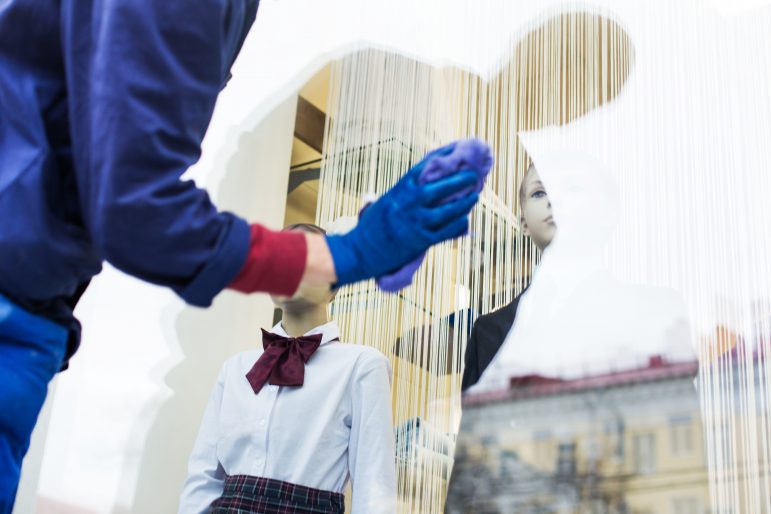The pandemic has drastically changed perception around building cleanliness. Now, two years since the beginning of the pandemic, many people continue to feel wary of public spaces – particularly in businesses that serve food and beverages. Over the past two years, facility maintenance professionals have helped businesses to not only clean for appearance, but to practice proactive cleaning for health and hygiene.
As restaurants, retail, and hospitality facilities continue to reopen, customers need to feel confident in facility cleanliness. Proactive cleaning and hygiene will be critical, and it’s an approach to facility maintenance that can be effectively implemented in any environment with four key steps:
Step 1: Set a cleaning benchmark
What constitutes clean in your facility?
The first step to ensuring your facility meets its cleaning goals is to set a benchmark of the current cleaning program. In hospitality and retail spaces, this should include reviewing cleaning routines to understand what areas are being cleaned, how often, and how effectively these cleaning methods are being executed.
This assessment helps to establish the appropriate cleaning protocols for each area of the facility. It serves as the starting point against which cleaning activities will be measured for compliance and allows managers to identify key cleaning areas that need to be addressed with additional cleaning processes. High-touch surfaces, traffic flow, and building occupancy are all key factors to take into consideration for benchmarking. This established cleaning standard will dictate cleaning tasks, frequency, specific products, and labour needed to successfully keep spaces clean and safe.
Step 2: Proactively ramp up cleaning
Understanding where high touchpoints are is one thing; keeping them safe is another. With a benchmark in place, the next step for increased infection prevention is to prepare all areas for increased foot traffic.
Here are the top three cleaning areas to focus on when standardizing cleaning routines in hospitality and retail spaces:
- Promote proper hand hygiene: When promoting proper hand hygiene, communication is key! Seventy-eight per cent of Canadians agree that they would feel safer if businesses clearly communicated which services, tools, or technology they are using to protect their customers. To help build customer confidence, ensure patrons are practicing proper hand hygiene before entering your space. Clearly communicate hand hygiene practices with posters, signage, and by training frontline team members to encourage hand sanitizer use at entrances.
- Ensure adequate product supply: Proper cleaning can’t be achieved without the necessary tools and products. Work with your supplier to ensure access to the supplies best suited to each space’s unique needs, paying special attention to hand hygiene products, disinfectants, and personal proactive equipment (PPE).
- Prioritize touchpoint cleaning and disinfecting: More than 84 per cent of Canadians think public spaces have an obligation to improve their disinfection practices for post-pandemic life to protect the health and safety of their customers. While it’s nearly impossible to keep high-touch surfaces completely free from bacteria, regular cleaning and disinfecting is critical to minimizing pathogens and the risk of disease outbreaks. Choosing easy-to-use disinfecting methods, such as disinfecting wipes or electrostatic disinfecting, reduces the barrier to completing disinfecting.
Step 3: Train your whole team
Proper facility cleaning and disinfecting is a big job that requires a team effort. Customer-facing employees in retail, restaurants, and other hospitality facilities can help lighten the load for already overstretched cleaning teams by taking on light disinfecting tasks. With the right training, customer-facing teams can disinfect high-touch surfaces between customers to help limit the spread of pathogens.
Ongoing workplace training is important in any industry – especially when it relates to the health and safety of others. For cleaning teams, staff training is critical to ensuring that chemicals and tools are used safely, tasks are performed correctly, and key cleaning areas have been addressed. Not sure where to start? Seek out industry cleaning training programs or talk to your cleaning supply specialist to help set staff up for success.
Step 4: Verify and validate cleaning
It’s time to ask “how do I know my space is actually clean?”
Having systems in place to verify and validate cleaning effectiveness is key when trying to meet customers’ cleaning expectations. While tracking all cleaning activities in a facility may seem overwhelming, smart cleaning management systems simplify the process by connecting people, devices, and equipment. These digital systems store cleaning protocols, products and cleaning plans, allowing them to work as a roadmap to guide staff through necessary cleaning tasks. They also have powerful reporting tools that provide detailed insight into completed cleaning activities. This is especially helpful when keeping track of touchpoint cleaning and disinfecting that needs to be performed multiple times a day.
System features and capabilities vary – some, such as the WandaNEXT™ platform, allow cleaning teams to log cleaning activities by scanning a room’s specific QR code, allowing for touch-free, accurate task logging. It also allows patrons to quickly and easily scan the codes to alert cleaning teams to service issues, elevating their experience and positioning the facility as exceptionally well maintained, clean, and safe. Talk to your cleaning supply provider to learn more about how these innovative tools can be customized to suit your facility’s unique needs.
David L. Smith is the Cleaning, Hygiene & Sanitation Director at Bunzl Cleaning & Hygiene, Canada’s largest specialist distributor of cleaning and hygiene products and equipment.
This article was also published in the Spring 2022 issue of FC&M magazine.









